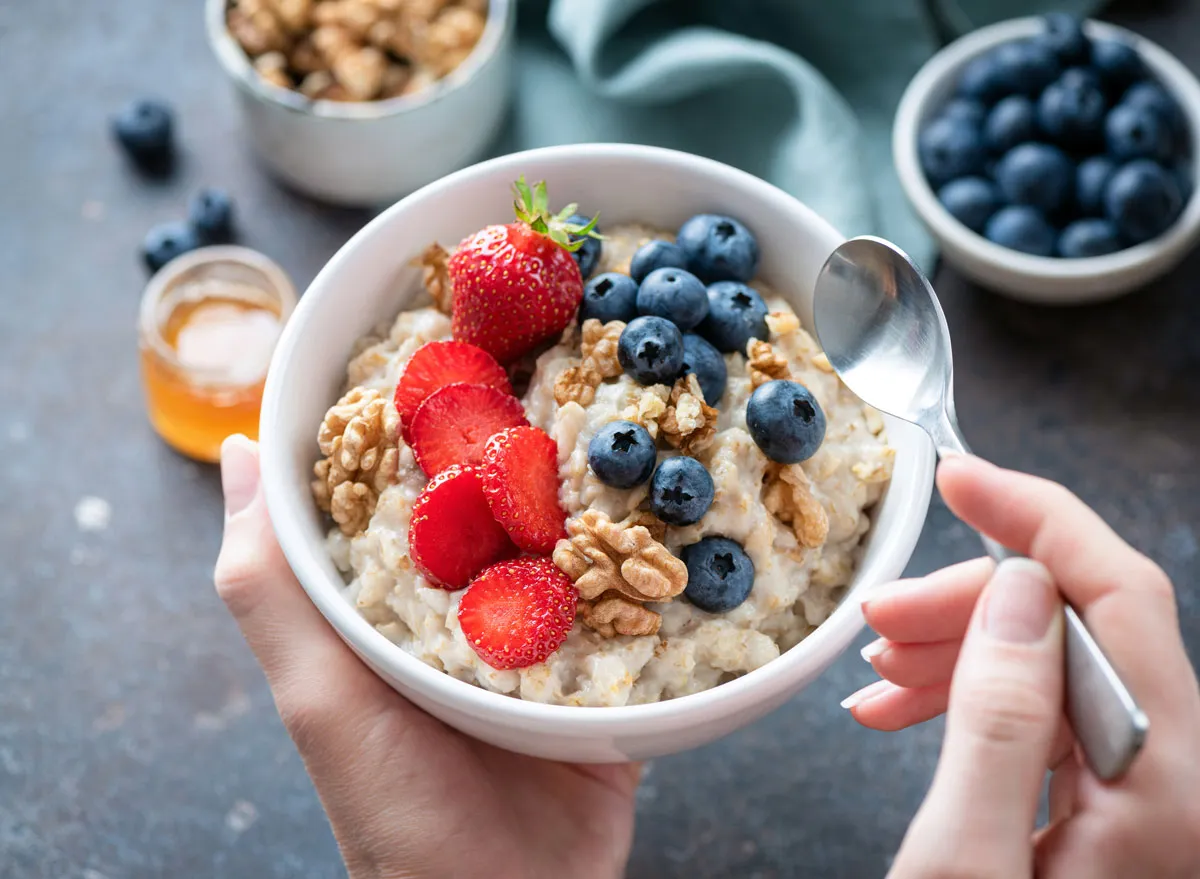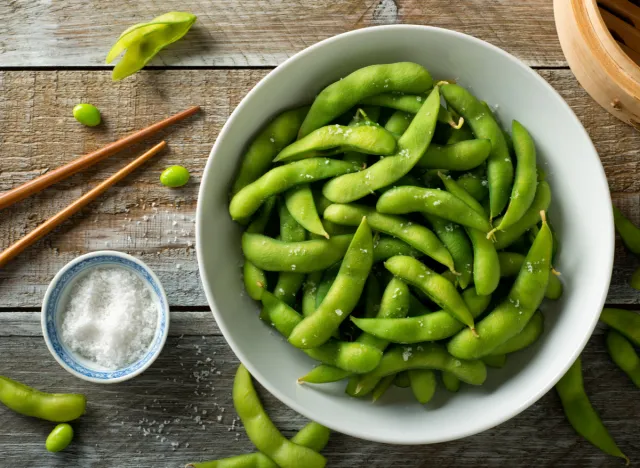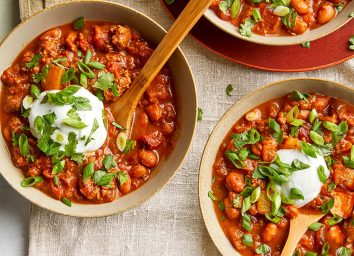
If you've set a weight loss goal for yourself, you may be aware of the frustration that comes with trying to lose fat specifically in your abdominal region. This type of fat around your belly, also known as visceral fat, can be stubborn and difficult to target. However, it is also one of the more dangerous types of fat, as carrying too much of it can lead to diseases and other health complications. If you're looking for help with this part of your weight loss plan, you may benefit from learning about specific foods linked to belly fat loss.
"Certain foods can contribute to weight loss which, over time, may reduce belly fat," says Lauren Manaker, MS, RDN. "For instance, foods high in protein, fiber, and good fats such as avocados, eggs, lean meats, and whole grains can support metabolism."
Let's look at how protein, fiber, and healthy fats can contribute specifically to belly fat loss. According to a report published in Nutrition & Metabolism, consuming high-quality protein was associated with lower levels of abdominal fat and waist circumference. This can be due to several reasons, including the fact that protein can reduce hunger hormones, increase lean muscle mass, and lower cravings.
When it comes to fiber, studies like one published in Obesity, have found that higher fiber consumption is linked to reduced belly fat. This study specifically found that with every 10-gram increase in fiber, there was a 3.7% reduction in abdominal fat over five years. Not only does fiber keep your digestion regular, which can reduce bloating in the abdominal area, but it has been found to help improve gut bacteria over time, and according to Genome Biology, better gut diversity has been linked to lower levels of abdominal fat.
Lastly, the consumption of healthy fats—aka monounsaturated—is known to help reduce overall body fat. According to Missouri Medicine, specifically replacing saturated fats with monounsaturated fat can help lower body fat levels.
Even though foods higher in protein, fiber, and healthy fats can help with your belly fat loss goals, it takes a balanced approach to accomplish this. Manaker emphasizes "that no single food can directly target belly fat." She says that instead, it's "A balanced diet, combined with regular exercise and adequate sleep, that is the most effective strategy for healthy weight loss."
While there aren't foods that burn belly fat on their own, the following list of foods can help with visceral fat loss by adding to a balanced diet full of protein, fiber, healthy fats, and other helpful nutrients. Read on, and for more healthy eating tips, check out 7 Best Antioxidant-Rich Foods to Reduce Inflammation.
Lean beef

If you need some lean protein that is going to help keep you full and aid in your goals of losing belly fat, some lean beef is an easy and delicious option.
"Protein helps you get full faster, increases feelings of fullness after meals, and supports muscle maintenance, which can lead to a slightly elevated metabolism," says Amy Goodson, MS, RD, CSSD, LD. "It also has a high thermic effect, meaning it burns more calories during digestion."
Oats

Protein is important for aiding in belly fat loss, and so is fiber. A food that is high in fiber (4 grams of fiber per 1/2 cup) and provides enough staying power to get you to the next meal is oats.
"High in beta-glucan fiber and complex carbohydrates, oats provide sustained energy and can help control hunger," says Goodson. "They can also help stabilize blood sugar levels, reducing the likelihood of overeating or craving sugar in the hours following a meal."
According to a study published in Critical Reviews in Food Science & Nutrition, there is a large body of evidence to support the fact that the beta-glucan found in oats can help reduce adiposity (also known as abdominal obesity) by way of better gut health, increased satiety, and gastric emptying.
Greek yogurt

According to Goodson, Greek yogurt is an excellent belly fat-burning food because it is high in protein and low in sugar. For example, there are about 20 grams of protein and seven grams of sugar in the average 7-ounce container of low-fat Greek yogurt. "High in protein, Greek yogurt can help control appetite and support muscle maintenance," she says.
"Plus, the probiotics in yogurt may promote a healthier gut microbiome, which has been linked to weight management," says Goodson. For instance, a 2021 study published in the American Society for Microbiology concluded that your gut microbiota can influence your weight loss process, meaning that the health of your gut is a crucial component of your weight loss journey.
Skinless chicken breast

If you're looking for another lean protein source that can help you with your weight loss goals, Tammy Lakatos Shames, RDN, CDN, CFT, and Lyssie Lakatos, RDN, CDN, CFT, also known as The Nutrition Twins, recommend turning to chicken breast.
"A 3-ounce chicken breast has only 123 calories and is packed with 24 grams of satisfying protein, and protein helps you to consume less food and fewer calories, contributing to belly fat loss because it's satisfying and stabilizes blood sugar, preventing energy crashes, and the cravings that come with it," say The Nutrition Twins. "Protein is also essential for maintaining and building lean muscle tissue, which fuels your metabolism, helping you to burn more fat, even when you're at rest. Getting adequate protein has been shown to increase weight loss and fat mass loss and preserve lean muscle tissue."
Raspberries

When you're in the mood for something sweet, a little bit tart, and still healthy, a handful of raspberries can make for a great snack to burn belly fat.
"They're sweet, low-calorie, no sugar added treats that are packed with antioxidants to fight inflammation that makes belly fat loss harder," say The Nutrition Twins. "Raspberries also can assist with weight loss because they contain the phytochemical cyanidin-3-glucoside (C3G) that has been shown to increase production of adiponectin, which may enhance fat metabolism, as well as leptin, which suppresses appetite."
Lemons

A lemon by itself may not be very satisfying, but implementing lemons into your favorite recipes can help with your belly fat loss goals, according to The Nutrition Twins.
"Lemons are ultra-low in calories, and spritzing them on food is one of the best lesser-known secrets that chefs use to add flavor without calorie-dense, fatty dressings, oils, and marinades," say The Twins. "Lemons contain potent polyphenols that may help to suppress body fat accumulation and prevent obesity, which means less fat everywhere, including the belly." Note that most of the research on lemon polyphenols and body fat has been in the form of animal studies, but the results so far are promising.
For ideas on how to incorporate more of this sour fruit into your diet, they suggest "Squeezing lemons over salads, fish, chicken, casseroles, tacos, and so much more, to get all the flavor while watching your belly fat shrink."
Sprouted bread

Getting enough fiber is crucial when trying to maintain a balanced diet that can help with belly fat loss, and sprouted, whole-grain bread is a helpful addition to your eating plan for this reason. In a regular slice of sprouted whole wheat bread, you'll get on average about 2 grams of fiber per slice.
Sprouted grain breads are made with grains that are fully allowed to sprout or germinate before they're turned into flour. These whole grains provide more fiber than refined white bread, and the sprouted grains are known to have better digestibility. Also, research shows that regular consumption of whole-grain products can help reduce visceral belly fat. In fact, a 2018 study of 50 Japanese participants found that eating whole wheat bread had a significant impact on their visceral fat loss while eating refined wheat bread did not.
Avocados

Avocado is a superfood known for its high content of healthy fats and versatility, making for the perfect addition to smoothies, salads, dressings, or as the base of delicious homemade guacamole.
Because of their monounsaturated fat content, avocados are known to help keep you feeling full and satiated. A 2013 study from Nutrition Journal found that eating fresh avocado (one-half of a whole one, to be exact) led to less of a desire to snack in between meals. Throwing avocado onto your toast, eggs, or bowl at lunch can help you stay away from mindless snacking and empty calories.
Eggs

As you can probably tell by now, lean protein is a crucial addition to any belly fat-burning eating plan. While foods like lean beef and chicken are good choices, eggs can be another helpful option and can be eaten at any meal of the day.
Whether you scramble them with your favorite vegetables, fry them over toast, or add a hard-boiled one to your salad, eggs provide a good source of protein and very little fat. In an average medium-sized egg, you're getting almost 6 grams of protein with less than 5 grams of fat. This makes it an excellent lean protein source for helping to lose more belly fat.
Along with their high protein content, egg yolks also contain a large amount of a nutrient called choline. According to the Journal of Human Kinetics, supplementing choline has been found to potentially help reduce your BMI while also lowering levels of leptin, a hunger hormone.
Salmon

Salmon is a delicious fatty fish with one of the highest concentrations of healthy omega-3 fatty acids. According to a 2015 study published in PLoS One, supplementing omega-3s can help you lose body fat and better manage it once it's off.
You can cook it fresh or frozen, enjoy it smoked on a piece of whole grain toast, or eat it canned with a handful of crackers and vegetables. Either way, you'll get a boost of healthy fats and protein to keep you feeling full and sustained.
Quinoa

Quinoa is a whole grain full of fiber and protein, which makes it the perfect belly fat-burning food. In one cup of cooked quinoa, you'll get about 5 grams of fiber and 8 grams of protein, all for less than 4 grams of fat. This grain is also one of the few plant-based complete proteins, meaning it has all of the amino acids your body needs—something that is more commonly found in animal proteins.
According to a 2017 study published in Current Developments in Nutrition, quinoa has been found to help with abdominal fat loss, as well as lowered blood triglyceride levels in participants who were considered overweight or obese.
Cottage cheese

Cottage cheese went viral after people discovered they could make high-protein, low-fat ice cream with this cheese as a base, and now everyone is coming up with their unique ways to use this protein-rich snack.
In one cup of 2% milk-fat cottage cheese, you can get up to 24 grams of protein with only five grams of fat and nine grams of sugar, proving that it can be a healthy addition to many types of snacks and meals that will fit perfectly into your weight loss plans.
On top of its protein content, cottage cheese can help support your weight loss goals because low-fat dairy products (like low-fat cheeses) have been found to help with abdominal fat loss.
Black Beans

As we mentioned earlier, along with eating enough protein, getting enough fiber in your diet is important for abdominal fat loss as well. When you need a fiber boost, black beans are ideal, as they provide 8 grams of fiber per half cup, as well as 8 grams of protein. According to a report published in Nutrients, the fiber content of beans and legumes is helpful in weight loss and avoiding weight gain.
Black beans are also versatile, so they're easy to add to a variety of different dishes like soups, salads, bowls, omelets, dips, and burritos.
Tuna

Tuna—whether canned, fresh, or frozen—is a known superfood for its high protein and healthy fat content. A 3-ounce serving of canned tuna offers a whopping 24 grams of protein and only 168 calories, while also consisting of around nine grams of fat, almost all of which is considered healthy poly- and monounsaturated fats.
Research also shows the link between eating fish when you're working toward weight loss. According to a report published in Nutrition Research Report, evidence shows that eating lean seafood (such as tuna), especially when you're choosing it over other meat products, can help prevent obesity.
Jicama

If you haven't jumped on the Jicama train yet, it's time to do so. This root vegetable can be enjoyed on its own as a filling snack or atop a salad for some added crunch. Either way, when you chow down on this vegetable you'll be getting a huge boost of fiber—a crucial nutrient for belly fat loss. In fact, just one cup of raw jicama contains 6 grams of fiber for only 50 calories.
Edamame

Edamame is more than an affordable appetizer to order at your favorite sushi restaurant. These soybeans are a healthy superfood full of protein and fiber, which means they'll give your body these two belly fat-blasting nutrients, as well as staying power and help in preventing overeating. In a cup of edamame, there are 8 grams of fiber and 18 grams of complete protein.
Along with edamame being high in protein, research has also found that soy consumption may potentially help in your abdominal fat loss goals. In one study published in The American Journal of Obstetrics & Gynecology, participants who consumed soy supplements lost 2.8% of their visceral fat, whereas those in the placebo group gained 5.3% visceral fat.
Green tea

Technically a belly fat-burning beverage and not food, "Green tea contains catechins, which have been shown to increase metabolism and promote fat oxidation," says Goodson. "The caffeine content can also provide a mild thermogenic effect, which may potentially help you shrink your belly when combined with a low-calorie diet and exercise."
If you're a fan of matcha tea—a specific type of green tea, you'll be happy to know that this drink is known to have 137 times more of a common fat-oxidizing green tea catechin called EGCG.
- Source: https://nutritionandmetabolism.biomedcentral.com/articles/10.1186/1743-7075-9-5
- Source: https://www.sciencedirect.com/science/article/pii/S0002916523292734?via%3Dihub
- Source: https://www.tandfonline.com/doi/full/10.1186/1550-2783-9-42
- Source: https://onlinelibrary.wiley.com/doi/full/10.1038/oby.2010.203
- Source: https://onlinelibrary.wiley.com/doi/full/10.1038/oby.2011.171
- Source: https://genomebiology.biomedcentral.com/articles/10.1186/s13059-016-1052-7
- Source: https://www.ncbi.nlm.nih.gov/pmc/articles/PMC9312452/
- Source: https://fdc.nal.usda.gov/fdc-app.html#/food-details/1101825/nutrients
- Source: https://www.tandfonline.com/doi/full/10.1080/10408398.2021.1994523
- Source: https://fdc.nal.usda.gov/fdc-app.html#/food-details/170903/nutrients
- Source: https://fdc.nal.usda.gov/fdc-app.html#/food-details/171535/nutrients
- Source: https://www.ncbi.nlm.nih.gov/pmc/articles/PMC6288909/
- Source: https://www.ncbi.nlm.nih.gov/pmc/articles/PMC2581754/#:~:text=Thus%2C%20feeding%20with%20lemon%20polyphenols,the%20mRNA%20levels%20of%20PPAR%CE%B1.
- Source: https://fdc.nal.usda.gov/fdc-app.html#/food-details/171850/nutrients
- Source: https://www.health.harvard.edu/blog/sprouted-grains-nutritious-regular-whole-grains-2017110612692
- Source: https://link.springer.com/article/10.1007/s11130-018-0666-1
- Source: https://nutritionj.biomedcentral.com/articles/10.1186/1475-2891-12-155
- Source: https://fdc.nal.usda.gov/fdc-app.html#/food-details/171287/nutrients
- Source: https://www.ncbi.nlm.nih.gov/pmc/articles/PMC4096089/
- Source: https://ods.od.nih.gov/factsheets/Omega3FattyAcids-HealthProfessional/
- Source: https://www.ncbi.nlm.nih.gov/pmc/articles/PMC4646500/
- Source: https://fdc.nal.usda.gov/fdc-app.html#/food-details/168917/nutrients
- Source: https://europepmc.org/article/med/26114306
- Source: https://www.ncbi.nlm.nih.gov/pmc/articles/PMC5998774/
- Source: https://fdc.nal.usda.gov/fdc-app.html#/food-details/172182/nutrients
- Source: https://www.ncbi.nlm.nih.gov/pmc/articles/PMC6791809/
- Source: https://fdc.nal.usda.gov/fdc-app.html#/food-details/175238/nutrients
- Source: https://www.ncbi.nlm.nih.gov/pmc/articles/PMC9864712/
- Source: https://fdc.nal.usda.gov/fdc-app.html#/food-details/173708/nutrients
- Source: https://www.ncbi.nlm.nih.gov/pmc/articles/PMC6536831/
- Source: https://fdc.nal.usda.gov/fdc-app.html#/food-details/170073/nutrients
- Source: https://fdc.nal.usda.gov/fdc-app.html#/food-details/168411/nutrients
- Source: https://www.ajog.org/article/S0002-9378(10)00284-X/fulltext
- Source: https://pubmed.ncbi.nlm.nih.gov/14518774/









